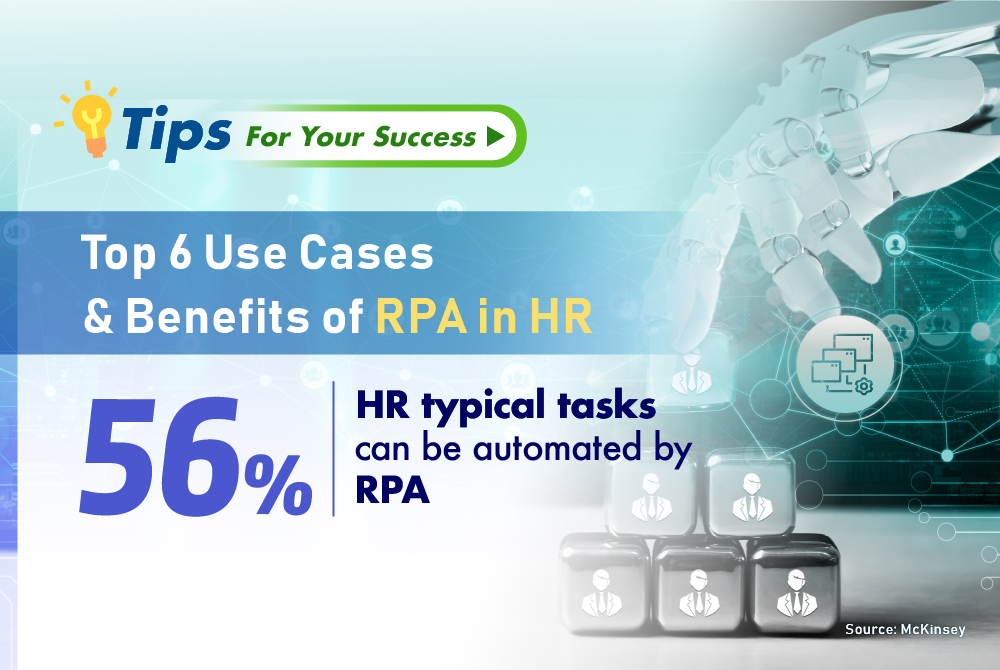Emerging Technologies
Top 6 Benefits of Robotics Process Automation (RPA) in HR

What is RPA?
Robotic Process Automation (RPA) , also called software robotics, combines APIs and user interface (UI) interactions to provide automation to handle repetitive back-office tasks or tedious paperwork such as capturing data, filling in forms or handling applications. In 2021, it was estimated that 20% of all organizations have already adopted RPA, rising from the 13% adoption rate in 2020. With their high productivity, RPA applications are being adopted by many sectors ranging from healthcare to HR.
When RPA comes to HR
Since the rise of chatbots interacting with job applicants, the efficiency of RPA tools has been grabbing the attention of HR professionals. In the past few years, a wide range of powerful RPA applications have been put into effect. This was highlighted by the result of the 2019-2020 Sierra-Cedar HR Systems Survey which showed that the use of RPA tools in HR functions has doubled over the past year. Research from McKinsey also mentioned that up to 56% of typical “hire-to-retire” HR processes could be automated with RPA technology. In the future, it is likely that more and more enterprises will be increasing the proportion of transactional HR tasks handled by RPA technology.
Top 6 Use Cases & Benefits of RPA in HR
From hiring to retiring (H2R) processes, RPA technology enables HR professionals to automate massive administrative tasks. The following are 6 of the most important and common use cases of RPA automation in HR.
1). Job Applicant Screening
Generally, one corporate job opening receives on average 250 applications. Screening all these resumes is definitely a time-consuming process. But with RPA automation, the resumes can be scanned thoroughly to see if the applicant’s skills match the job requirements and then given a reasonable score according to pre-set grading standards. After screening by RPA, the HR team can focus on proactive hiring processes such as talking to qualified candidates in person, while those who are filtered out through the selection process will be sent a rejection email automatically.
2). New Employee Onboarding
Research has shown that 58% of employees are more likely to stay for more than 3 years if they have experienced a good onboarding process. A well-constructed employee onboarding process should include a series of welcome meetings and orientation activities or training to help new hires adapt to the company and fast-track their productivity in the new role. In this case, by using RPA technology, once the candidate is hired, the RPA bots can be automated to kick off the entire onboarding flow such as sending a welcoming email and orientation notification, extracting personal information from the onboarding replies, or even inviting the new hires to fill in a survey regarding the overall orientation experience. Deploying RPA tools ensures a good onboarding experience for new hires as well as turns their understanding nervousness into excitement.
3). Payroll Management
Payroll processing is one of the most vital monthly tasks for HR and requires high accuracy and punctuality of data entry and tracking employee attendance. These tasks are already widely automated or assisted by RPA tools. An advanced RPA system can instantly handle a large volume of data entry tasks with zero error. In addition, as the RPA system is rules-based, MNCs (Multinational Corporations) can integrate different jurisdictions, such as labour laws from different countries into the system. Even if there are inconsistencies in the implementation of new regulations, the RPA system can review the whole database and make adjustments rapidly. Using RPA for practical functions like salary calculations, intermittent changes of payroll records, deduction of payroll and monthly reconciliation to the payroll records, are all highly efficient and effective ways to relieve the workload of payroll management.
4). Attendance and Reallocation Management
Tracking absences, attendance and overtime work are all tedious tasks for HR professionals and require a large amount of manual effort and time, especially for large companies. An advanced RPA system can easily validate the attendance records by cross-checking attendance systems and staff clocking in and out records. The system is also able to distribute notifications or alerts to employees. RPA tools can also design the most efficient reallocation of workforce resources in case of resignations or unexpected social issues, which can help to prevent disruptions to workflows and operations.
5). Employee Performance Review
Annual performance reviews are very important processes for employees and HR as they can help determine the number of annual bonuses and promotions. During the time of COVID-19, traditional face-to-face appraisals had already gone virtual. By integrating the cloud with RPA tools, HR can easily distribute the performance review assessments of different employees from different departments, and then analyse the data results and export them into comprehensive reports to show the overall performance score of employees and which tier they belong to. According to Engagedly, 70% of participants said that they were satisfied with the new style of virtual performance reviews.
6). Expense and Reimbursement Processing
Apart from payroll management, another thorny problem HR faces is managing business expenses, as well as reimbursement. Although most HR departments have adopted their own e-system for employees to submit their expenses for reimbursement, they are still required to monitor and respond to issues such as lost receipts, late submissions, lack of signatures and poor visibility of receipts. To relieve the workload of HR, RPA systems can be used to automatically screen all the applications and grant approval, while filtering out these cases with issues. The latest RPA systems can also support many functional features like credit card integration, currency exchange systems and 100% paperless receipt imaging.
Our Service
HKT RPA Solutions helps HR professionals to automate repetitive and routine tasks with 24/7 support and continuous optimisation, including data entry, payroll management, candidate screening and more. They are your best tools to reduce administrative workloads and increase productivity in human resource management.